1. Lee A. Wuhan novel coronavirus (COVID-19): why global control is challenging? Public Health. 2020; 179:A1–A2. PMID:
32111295.

3. Ahmed HO. The impact of social distancing and self-isolation in the last corona COVID-19 outbreak on the body weight in Sulaimani governorate- Kurdistan/Iraq, a prospective case series study. Ann Med Surg (Lond). 2020; 59:110–117. PMID:
32963773.

4. Ammar A, Brach M, Trabelsi K, Chtourou H, Boukhris O, Masmoudi L, Bouaziz B, Bentlage E, How D, Ahmed M, et al. Effects of COVID-19 home confinement on eating behaviour and physical activity: results of the ECLB-COVID19 international online survey. Nutrients. 2020; 12:1583.
5. Błaszczyk-Bębenek E, Jagielski P, Bolesławska I, Jagielska A, Nitsch-Osuch A, Kawalec P. Nutrition behaviors in Polish adults before and during COVID-19 lockdown. Nutrients. 2020; 12:3084.

6. Antunes R, Frontini R, Amaro N, Salvador R, Matos R, Morouço P, Rebelo-Gonçalves R. Exploring lifestyle habits, physical activity, anxiety and basic psychological needs in a sample of Portuguese adults during COVID-19. Int J Environ Res Public Health. 2020; 17:4360.

7. Đogaš Z, Lušić Kalcina L, Pavlinac Dodig I, Demirović S, Madirazza K, Valić M, Pecotić R. The effect of COVID-19 lockdown on lifestyle and mood in Croatian general population: a cross-sectional study. Croat Med J. 2020; 61:309–318. PMID:
32881428.

8. Kriaucioniene V, Bagdonaviciene L, Rodríguez-Pérez C, Petkeviciene J. Associations between changes in health behaviours and body weight during the COVID-19 quarantine in Lithuania: the Lithuanian COVIDiet Study. Nutrients. 2020; 12:3119.

9. López-Moreno M, López MTI, Miguel M, Garcés-Rimón M. Physical and psychological effects related to food habits and lifestyle changes derived from COVID-19 home confinement in the Spanish population. Nutrients. 2020; 12:3445.

10. Mumcu HE. Fitness-related on health mobile applications during COVID-19: case of Turkey. Prog Nutr. 2021; 23:e2021173.
11. Özden G, Parlar Kiliç S. The effect of social isolation during COVID-19 pandemic on nutrition and exercise behaviors of nursing students. Ecol Food Nutr. 2021; 1–19.

12. Güney OI, Sangün L. How COVID-19 affects individuals' food consumption behaviour: a consumer survey on attitudes and habits in Turkey. Br Food J. 2021; 123:2307–2320.

13. Kaya S, Uzdil Z, Cakiroğlu FP. Evaluation of the effects of fear and anxiety on nutrition during the COVID-19 pandemic in Turkey. Public Health Nutr. 2021; 24:282–289. PMID:
32972485.

14. Brooks SK, Webster RK, Smith LE, Woodland L, Wessely S, Greenberg N, Rubin GJ. The psychological impact of quarantine and how to reduce it: rapid review of the evidence. Lancet. 2020; 395:912–920. PMID:
32112714.

15. Mautong H, Gallardo-Rumbea JA, Alvarado-Villa GE, Fernández-Cadena JC, Andrade-Molina D, Orellana-Román CE, Cherrez-Ojeda I. Assessment of depression, anxiety and stress levels in the Ecuadorian general population during social isolation due to the COVID-19 outbreak: a cross-sectional study. BMC Psychiatry. 2021; 21:212. PMID:
33910550.

16. Shah SMA, Mohammad D, Qureshi MFH, Abbas MZ, Aleem S. Prevalence, psychological responses and associated correlates of depression, anxiety and stress in a global population, during the coronavirus disease (COVID-19) pandemic. Community Ment Health J. 2021; 57:101–110. PMID:
33108569.

17. Jackson A, Anderson A, Weybright E, Lanigan J. Differing experiences of boredom during the pandemic and associations with dietary behaviors. J Nutr Educ Behav. 2021; 53:706–711. PMID:
34162515.

18. Landaeta-Díaz L, González-Medina G, Agüero SD. Anxiety, anhedonia and food consumption during the COVID-19 quarantine in Chile. Appetite. 2021; 164:105259. PMID:
33857546.

19. Rodríguez-Martín BC, Meule A. Food craving: new contributions on its assessment, moderators, and consequences. Front Psychol. 2015; 6:21. PMID:
25657636.

20. Wu C, Chen X, Cai Y, Xia J, Zhou X, Xu S, Huang H, Zhang L, Zhou X, Du C, et al. Risk factors associated with acute respiratory distress syndrome and death in patients with coronavirus disease 2019 pneumonia in Wuhan, China. JAMA Intern Med. 2020; 180:934–943. PMID:
32167524.

21. Parekh N, Deierlein AL. Health behaviours during the coronavirus disease 2019 pandemic: implications for obesity. Public Health Nutr. 2020; 23:3121–3125. PMID:
32746955.

22. Gao F, Zheng KI, Wang XB, Sun QF, Pan KH, Wang TY, Chen YP, Targher G, Byrne CD, George J, et al. Obesity is a risk factor for greater COVID-19 severity. Diabetes Care. 2020; 43:e72–e74. PMID:
32409499.

23. Agnoli C, Grioni S, Sieri S, Sacerdote C, Ricceri F, Tumino R, Frasca G, Pala V, Mattiello A, Chiodini P, et al. Metabolic syndrome and breast cancer risk: a case-cohort study nested in a multicentre Italian cohort. PLoS One. 2015; 10:e0128891. PMID:
26030767.

24. Jia G, Martinez-Lemus LA, Sowers JR. Interaction of adipogenesis and angiogenesis in dietary-induced obesity. Diabetes. 2015; 64:2326–2328. PMID:
26106192.

25. Pathak RK, Middeldorp ME, Meredith M, Mehta AB, Mahajan R, Wong CX, Twomey D, Elliott AD, Kalman JM, Abhayaratna WP, et al. Long-term effect of goal-directed weight management in an atrial fibrillation cohort: a long-term follow-up study (LEGACY). J Am Coll Cardiol. 2015; 65:2159–2169. PMID:
25792361.
26. Caleyachetty R, Barber TM, Mohammed NI, Cappuccio FP, Hardy R, Mathur R, Banerjee A, Gill P. Ethnicity-specific BMI cutoffs for obesity based on type 2 diabetes risk in England: a population-based cohort study. Lancet Diabetes Endocrinol. 2021; 9:419–426. PMID:
33989535.

27. Zachary Z, Brianna F, Brianna L, Garrett P, Jade W, Alyssa D, Mikayla K. Self-quarantine and weight gain related risk factors during the COVID-19 pandemic. Obes Res Clin Pract. 2020; 14:210–216. PMID:
32460966.

28. Di Renzo L, Gualtieri P, Pivari F, Soldati L, Attinà A, Cinelli G, Leggeri C, Caparello G, Barrea L, Scerbo F, et al. Eating habits and lifestyle changes during COVID-19 lockdown: an Italian survey. J Transl Med. 2020; 18:229. PMID:
32513197.

29. Mason TB, Barrington-Trimis J, Leventhal AM. Eating to cope with the COVID-19 pandemic and body weight change in young adults. J Adolesc Health. 2021; 68:277–283. PMID:
33288456.

30. Drieskens S, Berger N, Vandevijvere S, Gisle L, Braekman E, Charafeddine R, De Ridder K, Demarest S. Short-term impact of the COVID-19 confinement measures on health behaviours and weight gain among adults in Belgium. Arch Public Health. 2021; 79:22. PMID:
33618770.

31. Boukrim M, Obtel M, Kasouati J, Achbani A, Razine R. COVID-19 and confinement: effect on weight load, physical activity and eating behavior of higher education students in Southern Morocco. Ann Glob Health. 2021; 87:7. PMID:
33505866.

32. Cheikh Ismail L, Osaili TM, Mohamad MN, Al Marzouqi A, Jarrar AH, Abu Jamous DO, Magriplis E, Ali HI, Al Sabbah H, Hasan H, et al. Eating habits and lifestyle during COVID-19 lockdown in the United Arab Emirates: a cross-sectional study. Nutrients. 2020; 12:3314.

33. He M, Xian Y, Lv X, He J, Ren Y. Changes in body weight, physical activity, and lifestyle during the semi-lockdown period after the outbreak of COVID-19 in China: an online survey. Disaster Med Public Health Prep. 2020; 1–6.

34. Hamer M, Gale CR, Kivimäki M, Batty GD. Overweight, obesity, and risk of hospitalization for COVID-19: a community-based cohort study of adults in the United Kingdom. Proc Natl Acad Sci U S A. 2020; 117:21011–21013. PMID:
32788355.

35. Rawat D, Dixit V, Gulati S, Gulati S, Gulati A. Impact of COVID-19 outbreak on lifestyle behaviour: a review of studies published in India. Diabetes Metab Syndr. 2021; 15:331–336. PMID:
33493852.

36. Özenoğlu A, Çevik E, Çolak H, Altıntaş T, Alakuş K. Changes in nutrition and lifestyle habits during the COVID-19 pandemic in Turkey and the effects of healthy eating attitudes. Med J Nutrition Metab. 2021; 1–17.

37. Karatas S, Yesim T, Beysel S. Impact of lockdown COVID-19 on metabolic control in type 2 diabetes mellitus and healthy people. Prim Care Diabetes. 2021; 15:424–427. PMID:
33441263.

38. Elmacıoğlu F, Emiroğlu E, Ülker MT, Özyılmaz Kırcali B, Oruç S. Evaluation of nutritional behaviour related to COVID-19. Public Health Nutr. 2021; 24:512–518. PMID:
33070798.

39. de Lauzon B, Romon M, Deschamps V, Lafay L, Borys JM, Karlsson J, Ducimetière P, Charles MA. Fleurbaix Laventie Ville Sante Study Group. The Three-Factor Eating Questionnaire-R18 is able to distinguish among different eating patterns in a general population. J Nutr. 2004; 134:2372–2380. PMID:
15333731.
40. Kıraç D, Kaspar EÇ, Avcılar T, Çakır ÖK, Ulucan K, Kurtel H, Deyneli O, Güney Aİ. Obeziteyle ilişkili beslenme alışkanlıklarının araştırılmasında yeni bir yöntem “Üç faktörlü beslenme anketi”. Clinical and Experimental Health Sciences. 2015; 5:162–169.
41. Anglé S, Engblom J, Eriksson T, Kautiainen S, Saha MT, Lindfors P, Lehtinen M, Rimpelä A. Three Factor Eating Questionnaire-R18 as a measure of cognitive restraint, uncontrolled eating and emotional eating in a sample of young Finnish females. Int J Behav Nutr Phys Act. 2009; 6:41. PMID:
19615047.

42. Torales J, O'Higgins M, Castaldelli-Maia JM, Ventriglio A. The outbreak of COVID-19 coronavirus and its impact on global mental health. Int J Soc Psychiatry. 2020; 66:317–320. PMID:
32233719.

43. Carter P, Anderson M, Mossialos E. Health system, public health, and economic implications of managing COVID-19 from a cardiovascular perspective. Eur Heart J. 2020; 41:2516–2518. PMID:
32320040.

44. Zhu Q, Li M, Ji Y, Shi Y, Zhou J, Li Q, Qin R, Zhuang X. “Stay-at-Home” lifestyle effect on weight gain during the COVID-19 outbreak confinement in China. Int J Environ Res Public Health. 2021; 18:1813. PMID:
33673375.

45. Schoeller DA. The effect of holiday weight gain on body weight. Physiol Behav. 2014; 134:66–69. PMID:
24662697.

46. Bhutani S, Wells N, Finlayson G, Schoeller DA. Change in eating pattern as a contributor to energy intake and weight gain during the winter holiday period in obese adults. Int J Obes (Lond). 2020; 44:1586–1595. PMID:
32203107.

47. Cooper JA, Tokar T. A prospective study on vacation weight gain in adults. Physiol Behav. 2016; 156:43–47. PMID:
26768234.

48. Karahan Yılmaz S, Eskici G. Evaluation of emotional (depression) and behavioural (nutritional, physical activity and sleep) status of Turkish adults during the COVID-19 pandemic period. Public Health Nutr. 2021; 24:942–949. PMID:
33292903.

49. Hawryluck L, Gold WL, Robinson S, Pogorski S, Galea S, Styra R. SARS control and psychological effects of quarantine, Toronto, Canada. Emerg Infect Dis. 2004; 10:1206–1212. PMID:
15324539.

50. Bhutani S, Cooper JA. COVID-19-related home confinement in adults: weight gain risks and opportunities. Obesity (Silver Spring). 2020; 28:1576–1577. PMID:
32428295.

51. Pearl RL. Weight stigma and the “Quarantine-15”. Obesity (Silver Spring). 2020; 28:1180–1181. PMID:
32324954.

52. Mattioli AV, Nasi M, Cocchi C, Farinetti A. COVID-19 outbreak: impact of the quarantine-induced stress on cardiovascular disease risk burden. Future Cardiol. 2020; 16:539–542. PMID:
32351128.

53. Braden A, Musher-Eizenman D, Watford T, Emley E. Eating when depressed, anxious, bored, or happy: are emotional eating types associated with unique psychological and physical health correlates? Appetite. 2018; 125:410–417. PMID:
29476800.

54. Serin Y, Şanlıer N. Duygusal yeme, besin alımını etkileyen faktörler ve temel hemşirelik yaklaşımları. J Psychiatr Nurs. 2018; 9:135–146.
55. Phillipou A, Meyer D, Neill E, Tan EJ, Toh WL, Van Rheenen TE, Rossell SL. Eating and exercise behaviors in eating disorders and the general population during the COVID-19 pandemic in Australia: initial results from the COLLATE project. Int J Eat Disord. 2020; 53:1158–1165. PMID:
32476163.
56. Dietz W, Santos-Burgoa C. Obesity and its implications for COVID-19 mortality. Obesity (Silver Spring). 2020; 28:1005. PMID:
32237206.

57. Yau YH, Potenza MN. Stress and eating behaviors. Minerva Endocrinol. 2013; 38:255–267. PMID:
24126546.
58. Torres SJ, Nowson CA. Relationship between stress, eating behavior, and obesity. Nutrition. 2007; 23:887–894. PMID:
17869482.

59. Pasquali R. The hypothalamic-pituitary-adrenal axis and sex hormones in chronic stress and obesity: pathophysiological and clinical aspects. Ann N Y Acad Sci. 2012; 1264:20–35. PMID:
22612409.

60. Coulthard H, Sharps M, Cunliffe L, van den Tol A. Eating in the lockdown during the Covid 19 pandemic; self-reported changes in eating behaviour, and associations with BMI, eating style, coping and health anxiety. Appetite. 2021; 161:105082. PMID:
33476651.

61. Devonport TJ, Nicholls W, Fullerton C. A systematic review of the association between emotions and eating behaviour in normal and overweight adult populations. J Health Psychol. 2019; 24:3–24. PMID:
28810437.

62. Evers C, Marijn Stok F, de Ridder DT. Feeding your feelings: emotion regulation strategies and emotional eating. Pers Soc Psychol Bull. 2010; 36:792–804. PMID:
20460650.

63. Koenders PG, van Strien T. Emotional eating, rather than lifestyle behavior, drives weight gain in a prospective study in 1562 employees. J Occup Environ Med. 2011; 53:1287–1293. PMID:
22027541.

64. Wardle J, Steptoe A, Oliver G, Lipsey Z. Stress, dietary restraint and food intake. J Psychosom Res. 2000; 48:195–202. PMID:
10719137.

65. Sevinçer GM, Konuk N. Emosyonel yeme. J Mood Disord. 2013; 3:171–178.
66. Broche-Pérez Y, Fernández-Fleites Z, Jiménez-Puig E, Fernández-Castillo E, Rodríguez-Martin BC. Gender and fear of COVID-19 in a Cuban population sample. Int J Ment Health Addict. 2020; 1–9.

67. Sidor A, Rzymski P. Dietary choices and habits during COVID-19 lockdown: experience from Poland. Nutrients. 2020; 12:1657.

68. Robinson E, Boyland E, Chisholm A, Harrold J, Maloney NG, Marty L, Mead BR, Noonan R, Hardman CA. Obesity, eating behavior and physical activity during COVID-19 lockdown: a study of UK adults. Appetite. 2021; 156:104853. PMID:
33038479.

69. Flanagan EW, Beyl RA, Fearnbach SN, Altazan AD, Martin CK, Redman LM. The impact of COVID-19 stay-at-home orders on health behaviors in adults. Obesity (Silver Spring). 2021; 29:438–445. PMID:
33043562.

70. Iannelli A, Favre G, Frey S, Esnault V, Gugenheim J, Bouam S, Schiavo L, Tran A, Alifano M. Obesity and COVID-19: ACE 2, the missing tile. Obes Surg. 2020; 30:4615–4617. PMID:
32451913.

71. Houston M, vanDellen M, Cooper JA. Self-weighing frequency and its relationship with health measures. Am J Health Behav. 2019; 43:975–993. PMID:
31439103.

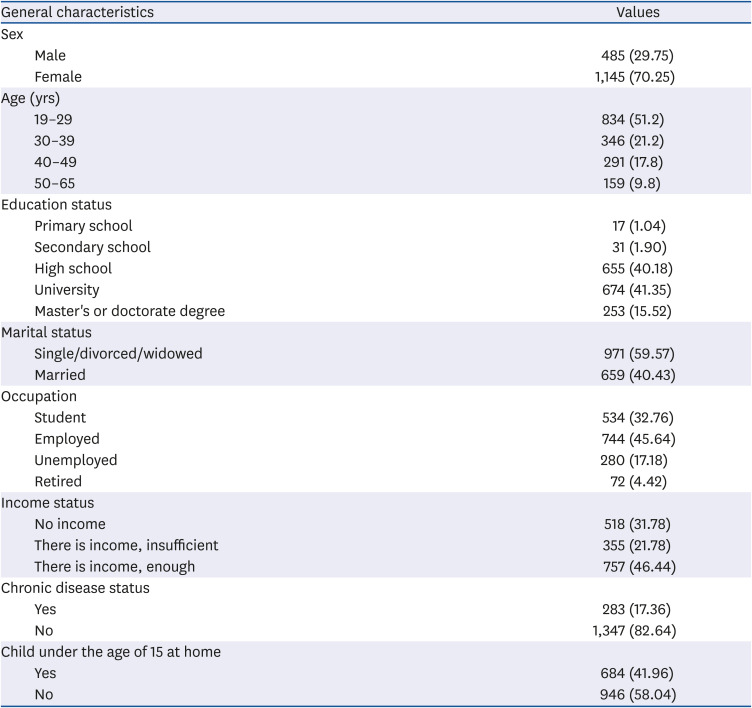
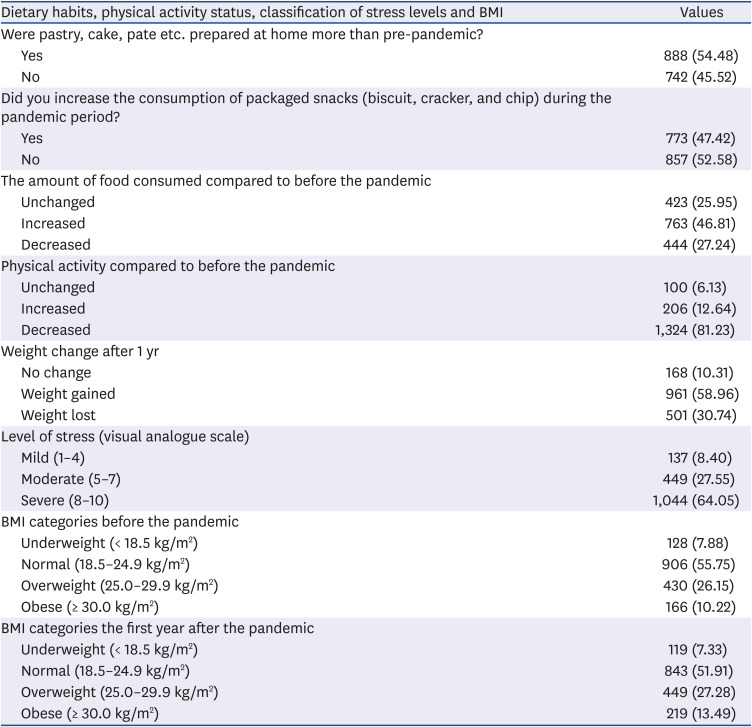
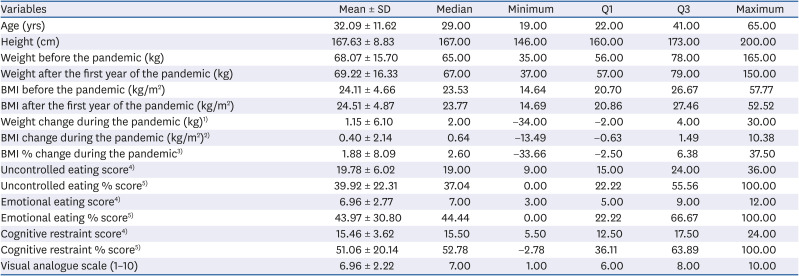
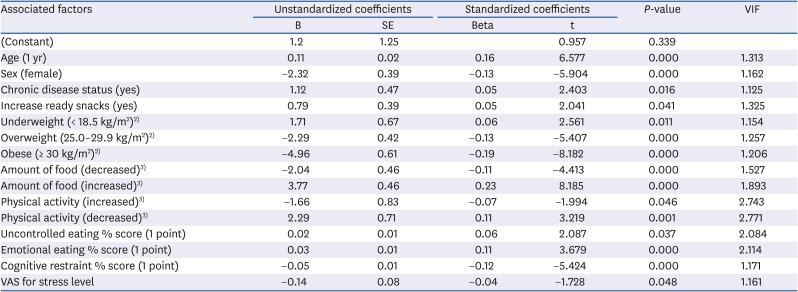




 PDF
PDF Citation
Citation Print
Print



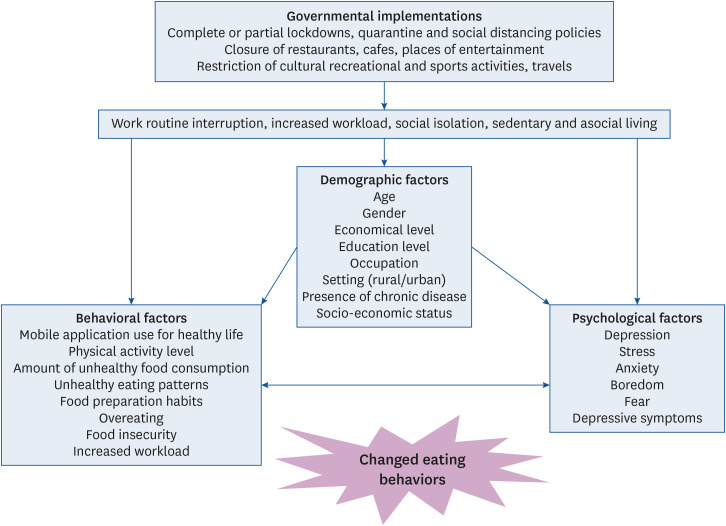
 XML Download
XML Download